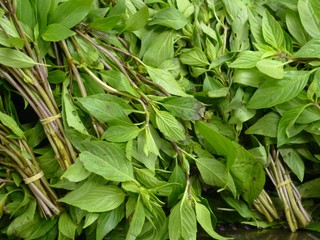How to grow Thai basil indoors

Thai basil is an aromatic herb, treasured for its unique flavor that’s spicier than regular basil and carries hints of licorice. Its dark green leaves and purple stems make it not just a culinary delight, but also a beautiful addition to your indoor garden. Growing it at home is straightforward and with our guide, you can have a fresh supply throughout the year.
To grow Thai basil indoors, you need a 6-inch pot, light potting soil or coconut coir, seeds or cuttings, and at least 6 hours of sunlight or a grow light. Keep the plant in warm conditions (above 70°F) and water when the soil’s top feels dry.
Why Grow Thai Basil Indoors?
- Year-round harvest: Indoor growing allows for a continuous supply, irrespective of the weather.
- Pest control: Being indoors significantly reduces the risk of pests, although you should still keep an eye out for common indoor plant pests.
- Fresher produce: Harvest right when you need it, ensuring the freshest flavor for your culinary creations.

Join our email club—get printable info cards free!
Sign up to receive our newsletter and get access to 10 printable plant info cards from our e-book for free. Also receive:
- $4 discount code for our Guide to Herbs e-book
- Semi-weekly plant inspiration & bite-size tips and tricks
Getting Started
Before diving into the growth process, ensure you have the necessary supplies:
- Containers: A 6-inch pot with proper drainage is ideal for starting out.
- Soil: Use light potting soil or coconut coir to offer the right mix of aeration and moisture retention.
- Seeds or cuttings: Begin with either Thai basil seeds or a cutting from an existing plant.
- Light: A sunny windowsill or artificial grow lights will suffice. Your basil needs at least 6 hours of sunlight to thrive.
Containers
A 6-inch pot is sufficient for a single plant; 3 plants can be grown together in a 12-inch container. Regardless of the material the container is made from, make sure it has drainage holes.
We have tried a lot of clay pots, and we prefer ones that come with mesh pads that prevent your soil from flowing out of the drainage hole. This one is 6 inches and comes in a four pack.
Soil
Commercial soil mixes and coconut coir both make a good substrate for growing plants. Both media are lightweight with excellent moisture retention. Fox Farm is one of our go-to potting soils; we find that it works especially great in container growing. You can purchase it here on Amazon.
To learn more about the best substrate for container-grown herbs, read our post on growing media.
Seeds or cuttings
Thai basil can be started from seeds purchased online or at your local garden center or propagated via plant cuttings.
Supplemental lighting
Plants growing indoors need lots of sunlight to grow big and healthy. If a room doesn’t have enough natural sunlight, like what we get outside, using grow lights can help.
If you’re looking for a good supplemental grow light, we recommend this one that you can find on Amazon. The timer function isn’t very reliable, but despite the low price it’s got a sturdy gooseneck and clip, and shines very bright.
Starting Thai basil from seeds
-
Preparation: Choose a high-quality Thai basil seed packet. Fresh seeds usually have a better chance of germinating.
-
Planting: Pour potting soil into your container, leaving about an inch from the top. Spread the seeds evenly over the surface, then sprinkle a thin layer of soil on top.
-
Watering: Use a spray bottle to mist the soil. Make sure it’s moist but not waterlogged.
-
Germination: Find a warm spot for your container, ideally at 70-75°F (21-24°C). The first sprouts should appear in 5-10 days. If you’re using a grow light, position it about 6 inches above the seeds, raising it as the plants grow.
-
Transplanting: When the seedlings have two sets of true leaves, consider moving them to a larger pot if they seem crowded.
Starting Thai basil from plant cuttings
-
Selection: Pick a healthy stem from an adult Thai basil plant.
-
Cutting: Use sharp scissors to snip a 4-6 inch piece from the stem. Strip the leaves off the bottom 2 inches.
-
Rooting: Place the cut stem into a glass of water, submerging the part where you removed the leaves. Choose a bright location for the glass, but avoid direct sunlight. In a week or two, you’ll see roots!
-
Planting: Once the roots are about 2 inches, plant the cutting in a pot. Cover the roots with soil.
-
Care: Give the plant a bit of water right after planting. Keep the soil damp, but don’t let it get soggy.
How to care for your Thai basil plants
Once you’ve got your Thai basil growing, taking good care of it is the key to a plentiful harvest. Here’s a simple guide to keep your plants thriving:
Light requirements
Thai basil loves light! Give your plants lots of bright, indirect light. If you can’t get sunlight all day, a grow light can help. Try to give your plants at least 6-8 hours of light each day.
Temperature needs
These plants prefer warmth. A room temperature of 70-75°F (21-24°C) is perfect. Keep your plants away from cold drafts or very hot spots.
Watering guidelines
Thai basil likes its soil a bit moist. Touch the soil with your fingers. If the top feels dry, it’s time to water. But be careful! Too much water can drown the roots.
Pruning guidelines
Make your basil bushy and full by snipping the top tips. This helps the plant grow more leaves. If you see flowers, pinch them off. This keeps the plant focused on growing leaves.
Harvesting guidelines
When your plant is big and leafy, you can start picking leaves. Use clean, sharp scissors or your fingers to snip leaves or stems. Always leave a few leaves on the plant so it keeps growing. Fresh basil is best, but you can dry or freeze extra leaves to use later.
For maximal taste, harvest mid-morning on a sunny day when essential oils are at their peak. Make sure to harvest basil leaves before plants flower, otherwise the leaves lose their nice flavor. If they do bloom, remove all flowers and wait to harvest for a couple of days.
If your plant is overgrown, you can do a more severe harvest. Starting from the top of the plant, begin harvesting stems, taking the plant down to 6 inches tall. Never cut into the woody parts of the stem, or the plant won’t resprout.

Common challenges and solutions
- Leggy plants: A sign of insufficient light. Bring your basil closer to the light source or consider additional grow lights.
- Yellowing leaves: Overwatering might be the issue. Wait for the topsoil to dry before the next watering.
- Pests: Aphids or whiteflies can occasionally be a problem. Combat them with insecticidal soap or neem oil.
Differences between Thai basil and other basil varieties in growing
While there are several types of basil that gardeners and chefs love, Thai basil stands out not only for its distinct flavor and appearance but also in how it grows. Let’s explore the key differences in growing Thai basil compared to other basil varieties:
1. Temperature tolerance
Thai basil is more heat-resistant than many other basil varieties, especially compared to sweet basil. While most basil types may wilt or struggle in excessive heat, Thai basil thrives, making it ideal for summer gardens.
2. Growth structure and height
Thai basil plants typically grow taller and have sturdier stems than many common basil types like sweet basil. They can reach a height of up to 12-18 inches and tend to have a more upright growth pattern.
3. Flowering
Thai basil flowers earlier and more frequently than most basil varieties. These purple or deep-red flowers are not just attractive; they’re also edible. However, just like with other basil types, we recommend to pinch off the flowers if you want to prolong the plant’s leaf-producing period.
4. Pest resistance
While all basil plants are known to repel pests like flies and mosquitoes, Thai basil has a robustness against aphids that might trouble different basil varieties.
5. Soil requirements
Though most basil types, including Thai basil, prefer well-draining soil, Thai basil is slightly more forgiving of soil that’s not perfectly drained. It can tolerate a bit more moisture than, say, sweet or Genovese basil.
6. Harvesting time
Due to its sturdy nature and faster growth rate, Thai basil is often ready for harvesting slightly sooner than other basil types. Regular harvesting encourages bushier growth and prevents early flowering.
FAQ
How often should I water Thai basil?
When the topsoil feels dry. Avoid saturating the soil.
Can I move Thai basil outdoors?
Certainly! Transition it outside when the weather is consistently warm.
How long does it take to grow Thai basil from seed?
When started from seed, it takes approximately 60 to 90 days for a Thai basil plant to get large enough to harvest. Plants will grow quicker in warmer temperatures and higher sun exposure, than those grown in cooler rooms with less available sunlight.
When should I prune Thai basil?
Begin pruning once it’s about 6 inches tall for a bushier plant and prolonged growth.

The enthusiast's guide to herbs
We’re proud to present our new e-book, The Enthusiast’s Guide to Herbs! Learn everything you need to know about growing and caring for herbs indoors, including in-depth info cards for the 35 most commonly grown herbs.
Click the link below to find out more!
